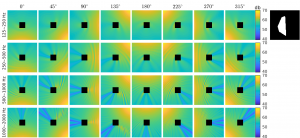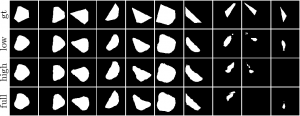Prediction of Object Geometry from Acoustic Scattering Using Convolutional Neural Networks
Ziqi Fan, Vibhav Vineet, Chenshen Lu, T.W. Wu and Kyla McMullen.
arXiv preprint | arXiv:2010.10691. [download pdf]
The Helmholtz equation governs the acoustic fields around the boundaries of objects in the frequency domain. However, it is difficult to derive a general analytical solution for the object boundaries from the acoustic field. A potential method is to train a convolutional neural network using the acoustic scattering data as a training dataset. This project is the first step to investigate the inverse problem emphasis on data. The experiments show that the CNN model is able to infer the object boundaries accurately by the synthetic acoustic field.

The above image illustrates an input-output pair to the neural network. The input is a 32-channel image describing the sound field around the object in an inaccessible region, 4 channels for octave bands, and 8 channels for source locations. The small black squares in the center of each sound field image represent an inaccessible area. The inside of the area can not be seen from the outside. The output is a binary image indicating the geometry of an object in the inaccessible region.

The above image illustrates the boundary predictions using different combinations of octave bands. The ground truth of the object boundaries is listed as the top row.
Dataset Download Link:
The training dataset and test dataset can be downloaded from the site. The acoustic high-performance numerical solver can be found in Acoustic High-Performance Solver.
